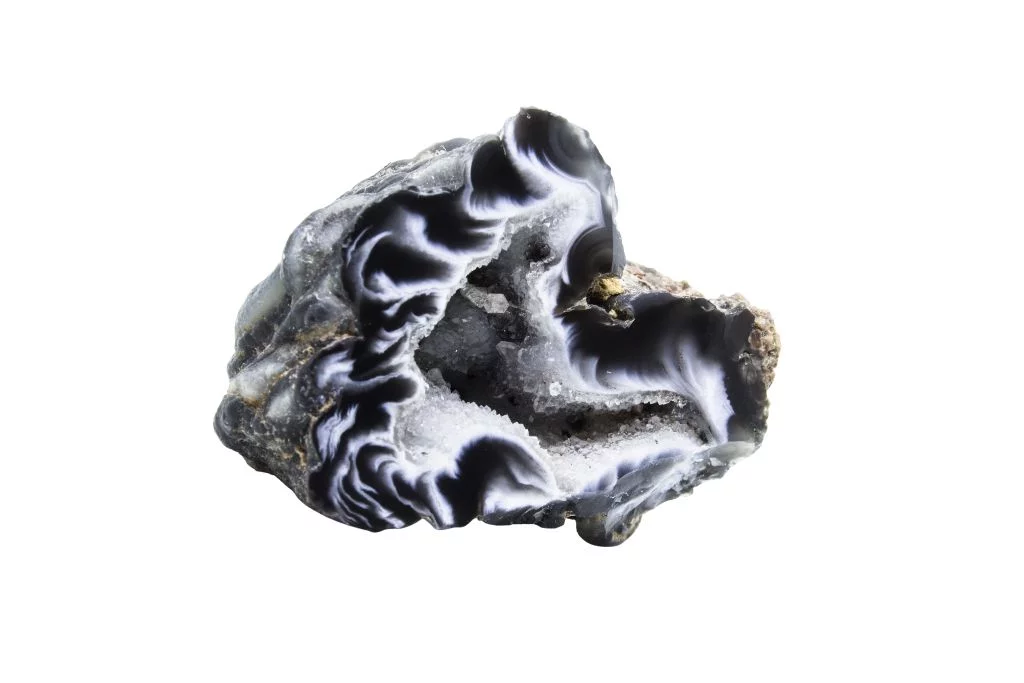Formation of Agate Geodes
Agate geodes begin their journey as cavities within volcanic or sedimentary rocks. Over millions of years, mineral-rich groundwater seeps into these cavities, depositing layers of silica. This slow process results in the distinctive banded structure that characterizes agates.
Exterior Appearance
From the outside, agate geodes often appear unremarkable. They typically have a rough, rocky exterior that gives little hint of the beauty within. This outer layer can range in color from dull gray to brown, depending on the surrounding rock formation.
Internal Structure and Colors
When split open, agate geodes reveal their true splendor. The interior showcases concentric bands of vibrant colors, creating a mesmerizing pattern. These bands can appear in a wide spectrum of hues, including shades of blue, purple, red, orange, and yellow. The colors are often translucent, allowing light to pass through and enhance their brilliance.
Banding Patterns
One of the most distinctive features of agate geodes is their banding pattern. These bands can be straight, curved, or form complex geometric shapes. The thickness of each band can vary, creating a unique fingerprint for every geode. Some agates display a “fortification” pattern, where the bands form angular, concentric shapes resembling the walls of a fort.
Crystal Formations
At the center of many agate geodes, you’ll find a hollow cavity lined with inward-pointing crystals. These crystals are often quartz and can range from tiny, sparkling points to larger, well-formed crystals. This crystalline core adds another dimension of beauty to the geode’s appearance.
Unique Characteristics
What makes agate geodes truly stand out is their individuality. No two are exactly alike, with each specimen presenting its own unique combination of colors, patterns, and crystal formations. Some may contain inclusions of other minerals, creating striking contrasts or unusual effects. The combination of smooth, banded agate and crystalline quartz creates a captivating juxtaposition of textures that appeals to both collectors and enthusiasts.
Historical and Cultural Significance of Agate Geodes
Agate geodes have been prized for centuries across various cultures. Ancient civilizations, including the Egyptians and Greeks, valued these stunning formations for both decorative and spiritual purposes. In some Native American traditions, agate geodes were believed to possess protective qualities and were used in sacred ceremonies.
Metaphysical Associations
In the realm of crystal healing and metaphysics, agate geodes are often associated with balance, harmony, and grounding energies. They are thought to promote emotional stability and inner strength. Many practitioners believe that the hollow nature of geodes symbolizes the womb, representing potential and new beginnings.
Common Uses and Applications
Today, agate geodes find applications in both traditional and modern contexts. They are widely used in jewelry making, with slices of geodes incorporated into pendants, earrings, and other ornamental pieces. In home decor, large agate geodes serve as striking display pieces or bookends. Some people use smaller geodes in meditation practices, holding them as focal points for concentration and reflection.
Believed Benefits
Proponents of crystal healing attribute various benefits to agate geodes. They are said to enhance mental function, improve analytical abilities, and foster creativity. Some believe that placing agate geodes in living spaces can help cleanse negative energies and promote a sense of calm. In alternative medicine practices, these formations are sometimes used to address issues related to the digestive system and to alleviate stress-related ailments.

